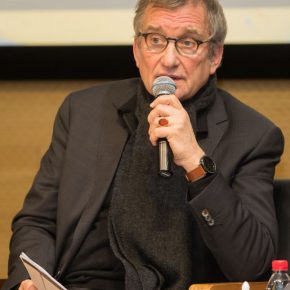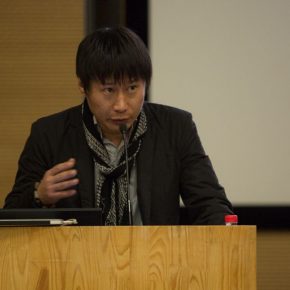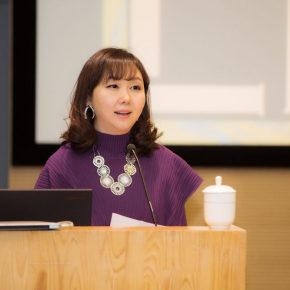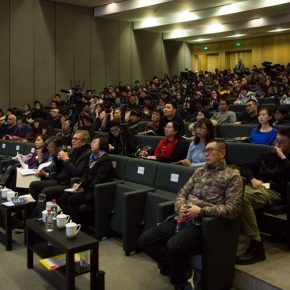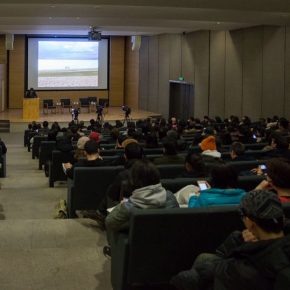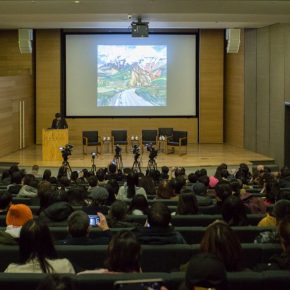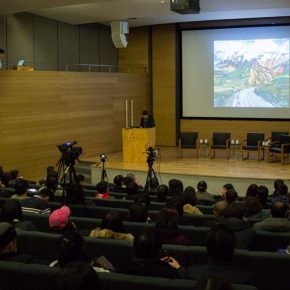
In 2017, artist Liu Shangying presented a solo exhibition on “Living Natures” in E’jina Desert in Inner Mongolia, where he displayed his series of works created in this environment over three consecutive years. On January 17, 2018, an academic lecture entitled “Living Natures – Art and Nature” was held in the Auditorium of CAFA Art Museum with Fan Di’an, President of CAFA, the curator Olivier Kaeppelin and artist Liu Shangying using this exhibition to start to explore the presentation of the exhibition and behavior style of the artist who painted on-site in the natural arena and it is extended to the differences and common issues of “art and nature” in Chinese and Western cultures, and it also inspires so it is possible to have a new relationship between contemporary art and nature during the times of the image. The lecture was hosted by Prof. Shao Yiyang, Deputy Dean of the School of Humanities and Doctoral Supervisor.
At the beginning of the lecture, Prof. Shao Yiyang introduced the “Living Natures” exhibition which was not in the art museum, but was located?in the ruins of the red town, near the dead but immortal populus diversifolias and an opening ceremony & conference were held in the E’jina Desert. This form is destined to be an exhibition worth discussing. Shao Yiyang also believed that Liu Shangying’s creation had a strong feeling of romanticism, and this romanticism is people’s exploration in the nature, the fear and conquest of nature, rather than the usual feeling of beauty, poetry and love. Liu Shangying has been creating works in such remote places as Ali in Tibet and E’jina Desert in the Inner Mongolia. His creation is to fight against nature. Liu also said that he was engulfed in the desert, rather than the wind and sand which defeats him.
Fan Di'an, President of CAFA delivered a speech at the opening ceremony and said “art and nature” was an ancient artistic proposition and a topic which can’t be ignored in the development of contemporary art. It includes both the “artistic practice” and “artistic thinking”. In terms of artistic practice, Liu Shangying has been traveling alone, walking in China, for many years, and has created many works at the scenes of humanity, history and nature, which is a form of self-consciousness of the artist. In terms of artistic thinking, it has triggered the Eastern and Western approaches toward philosophical thoughts of nature, art and life, considering the possibility of the breakthrough of painting. At the same time, the topic of “art and nature” is linked with different cultural contexts, for example, the “l(fā)iving natures” is translated into “the field of life” in Chinese, although there is not any literal connection, it has the inherent connection between the artist’s individual life and natural life with the artistic expression.
At the lecture, artist Liu Shangying detailed his experiences and feelings of creating in nature over the years. The state and manner of his creation stemmed from long-distance travels, such travels have changed his familiar life and the inertia state, and he clearly see the ego when he goes far away. The majority of Liu Shangying’s works are themed on landscape or nature. In the view of the artist, the scenery is not a scene that people are facing, but a 360-degree field. In Tibet, for example, he felt a great sense of indifference and alienation linked with life experiences in beauty. In the E’jina Desert, the dead populus diversifolias are the incarnation of power, which is created when confronting with the harsh natural environment, and he feels a penetrating vitality in the desert, drought and death. The feeling of the unusual field has also changed Liu Shangying’s feelings of the art. The light of Tibet has subverted his previous understanding of light, and he also started to abandon a color palette and to enter a semi-uncontrolled state, working with the wind and sand, which prompted him to think of the inextricable connection between nature and human spirit. He began to forget the past experiences and attached importance to the experience and integration. Drawing is an exchange between man and nature about life experiences rather than a simple visual activity. In his paintings, both populus diversifolias and wind & sand are not?referential images in the general sense. He does neither set the concrete, or abstract, nor set the subject or object, the subjective and objective, and even fails to preset a time to stop drawing, but he hopes to break the relationship between the close shot, medium shot and distant shot, to build a multi-layer space from his own experience in the painting.
Speaking of the exhibition of “Living Natures” which was held in the ruins of the red town, Liu Shangying thought that the relationship between the work and space has changed in this place, the boundary has been broken, and the environment has become part of the painting, while the painting has also become part of the environment, with an invisible and visible relationship. At the same time, the exhibition has constituted a new order and circle in space and time. The artist has recorded the changes from the exhibition on one day in aerial photography. Starting from sunrise, sunset to night, the paintings were blended in the surrounding nature, constantly changing, and the exhibition has become a stamp in the desert with a bird’s-eye view of the scene. The art thus brings a new meaning to the desert, while the desert has given the art a new state of life as a feedback of its own system.
In this lecture, the three speakers delivered keynote speeches on the landscape painting, and the extended relationship between nature and art. As an artist, Liu Shangying said frankly that he was not interested in drawing a landscape painting in the traditional sense, but was more concerned with the relationship with nature, which is naturally open-minded and unpredictable. There will be many propositions that started form the sand under your feet to a star in the sky. Instead of drawing landscapes, he draws a painting in the landscape and returns to an original state of life in his creation, while the prehistoric nature gives him more revelations about life. Curator Olivier Kaeppelin said that the landscape was not nature and people could be in nature, such as the peasants working in the fields, while people could also be outside the scenery, such as people visiting a garden. Nature has always been there, and we are always in the middle of nature. When we look at nature, we see objects including people and animals. Olivier Kaeppelin took the studies of languages in Europe as an example, to propose that language did not automatically transfer information, and the artists should think of how nature passed on messages, and a consideration on this topic does not simply start from the natural form. Fan Di’an, President of CAFA, mainly expounded the understanding of “nature” from the cultural context of China. The term of “nature” can be traced back to “Tao Te Ching” – human beings follow earth, earth follows heaven, heaven follows the Tao, the Tao follows the way things are – it is nature which can be attributed to the truth. Thus, the original intention of “nature” is not the landscape, but the law and orientation of life, describing the relationship between a person and the world. Since then, “nature” has evolved into a material nature of the world, and there has been a gap between people and things, so that people have tried to bridge this separation. Therefore, Chinese painting has not embarked on the road of demonstrating the authenticity of objects like Western panting, but has always embraced the respect and exploration of nature. What is needed to be achieved in Chinese painting is not a matter of portrayal but the mind of the self is purified and sublimated in the process, and the painting is a seal of the mind. Liu Shangying’s creation is an integration of body and mind, when he faces landscape and nature. Instead of gazing, the artist looks around to gain specific feelings, and looks for an “empty” “ideal condition of having no humans”, and only the emptiness is able to accommodate all concepts. Nature is a paradox for his creation, while he must both face the real landscape, and avoid depicting the real landscape.
At the same time, the discussion examines the relationship between Liu Shangying’s paintings and traditional Chinese landscape paintings, action paintings and European landscape paintings. Olivier Kaeppelin remembered the first discussion with Liu Shangying, on the Chinese landscape painter Gong Xian, in whose paintings, the figures are very small, and Liu Shangying himself is like a small insect in the vast nature of his paintings. Olivier Kaeppelin also found that Liu Shangying was fighting with the wind and sand when he was drawing, which was different from Western artists who threw sand into the paintings and the wind and sand seemed to act as partners in Liu Shangying’s paintings that participated in the completion of the works. Olivier Kaeppelin explained that “nature” was interpreted as “natura” in Latin, meaning the “birth”, that is to say the nature itself was related to birth, movement, and forthcoming birth, which was just like a seed that was about to come out of the dark subterranean to chase the sun. Pollock’s action painting is a horizontal movement; Kishio Suga’s creation which is from the roof to the ground, is a vertical movement; Kiefer’s works show a double relationship covers both seeing the nature and entering nature. These artists hoped to express their paintings with different forms of energy in different dimensions. Liu Shangying’s works actually bring together many rivers in his mind. From ancient China to modern Europe, he has always had a dialogue, and different sources that have an impact on Liu Shangying’s works. Fan Di’an said that there was also an activism similar to modern Pollock’s action painting in ancient China. For example, “freeing oneself from fetters” means that the action energy can be brought into the creation of art, or that action can become an energy. Fan Di’an offered a reference for understanding the “nature” of Liu Shangying’s paintings through the interpretation of the art of Munch and David Hockney. In addition to the performance of hardship in creation, Munch also created many landscape paintings, which contained a spiritual meaning that had Western aesthetic ideas about loftiness and tragedy. Compared with Munch’s paintings of forest, Liu Shangying applies a traditional figurative painting, which is also a manifestation of his life experience. He does not analyze nature’s structure, but highlights the unity of his artistic expression and the natural life that he personaly feels. David Hockney has shuttled across both shores of the Atlantic, has always had a close-knit attitude to nature and the use of new technologies to express nature, such as polaroid cameras and iPads, as well as studying the traditional Eastern viewing methods and expanding the dimensions of his performance...
Liu Shangying’s creation, exhibition and this lecture are all conducted around nature and art. The host Shao Yiyang dished out a question at the end: Between nature and art, which has more vitality? Liu Shangying quoted the English artist Auerbach’s view that the touching scenery seen in the painting is more exciting than the real scenery. It is a parallel relationship between nature and art, and people are also part of nature. Nature itself has a sense of life, and it is given by man’s mind and spirit to nature, which is activated by art and forms another form of nature. From this perspective, art should go beyond nature. In turn, nature does not need people to portray praise, but does attract people to follow it. American writer Thoreau elaborated the reason why he wanted to become a naturalist in the “Walden”, which shows that there is a profound relationship between man and nature and it is a parallel relationship between nature and art, while the key point is which perspective we choose to elaborate. Fan Di’an mentioned an ancient Chinese saying, “The scenery is like a picture”, seen from a common perspective, art is more vivid and beautiful than nature. However, how can it be based on nature and enter the vast space provided by nature in the process of art creation, especially when feeling physically and mentally, it is not just the specific scenery that he is facing, but a state of mind. Therefore, the conception is painted rather than painting the scenery. From this perspective, it is difficult to answer which has more vitally, and both feel the powerful vitality from different perspectives.
After listening to the lecture, Prof. Sui Jianguo, from the Department of Sculpture at CAFA, also described his understanding of nature and art: nature is a kind of natural law, which couldn’t be shifted by people’s will, and people have to accept it. All the arts can only accept the art, and people have digested nature through art. Nature is realistic, while people live on the symbolic and semiotic. When Liu Shangying reached Tibet and Inner Mongolia, the realistic world exposed one aspect to him, and he found that the former things were useless because previous symbols or signs copied the others, so, he could only face nature. Therefore, these paintings by Liu Shangying are struggling with the realistic. When you confront the realistic to express surprise and confusion, you are also digesting nature for human beings and creating a human civilization. Contemporary art means that new art is created when you do not have any other means.
Text by Zhang Wenzhi, Photo by Hu Sichen/CAFA ART INFO
Translated by Chen Peihua and edited by Sue/CAFA ART INFO



